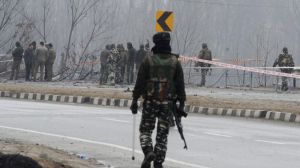The great pall of China
The Chinese government has left no stone unturned to ensure that the Olympic games in August next year will be a grand success.

The Chinese government has left no stone unturned to ensure that the Olympic games in August next year will be a grand success. This is China’s opportunity to display to the world the rapid strides it has made in development and its cutting edge infrastructure. In preparation for the games Beijing has undergone a metamorphosis. Billions have been spent on massive construction projects, which includes not just stadiums but also a new airport, highways, subways and even a brand new opera house.
But there are some wrinkles which even the super efficient Chinese, despite their money-no-object attitude, find hard to iron out. The Beijing municipal government has spent $120 billion over the last ten years in controlling pollution and greening the city. But the grey haze and smog which covers Beijing has not disappeared. Olympic officials have even expressed fears that some of the more strenuous games like cycling may have to be postponed or venues changed because of pollution.
The authorities are working on a war footing to combat, what is jestingly described as the great pall of China, Beijing’s endless traffic jams and smog. The city’s energy sources have been switched from coal to natural gas and electricity. Two hundred polluting factories have been closed down or re-located A major iron and steel factory has been shifted to Kobe. The Beijing Chemical and Coking Plant, a prominent landmark, has been closed down. ( In communist China workers views about such arbitrary transfers are apparently not taken into consideration. ) Three thousand buses and 50,000 taxis are to be replaced by gas fuelled vehicles. Twenty million trees have been planted to create 31 new parks, a forest park, a walnut park and artificially green a nearby hill.
As part of a three- day experiment in controlling traffic jams and pollution, half the city’s cars were kept off the roads on alternate days. Sun Weide the deputy director Beijing organisation committee for Olympics claims that the anti-pollution drive is showing results. In 1998 there were only 100 good days in Beijing, last year there were 241 days, where particulate matter and sulphur dioxide was within acceptable limits. But his figures seem a trifle suspect. Beijing residents say they are lucky if they get one clear day with a blue sky in a fortnight. The Chinese are now thinking of experimenting by taking all cars off the road.
Another imponderable to contend with is the weather. The main stadium has no roof and meteorological experts suggest there is a 50 per cent change of rain which would ruin the opening ceremony. The enterprising Chinese are experimenting with cloud seeding technology to make sure it rains before and not on D day.
The authorities have also gone in for mass scale English lessons so that the locals will be in a position to communicate with the half a million international visitors expected for the games, apart from one million Chinese tourists. The Chinese optimistically predict that half of Beijing’s population will speak the language by the time the games begin.. The Beijing municipal corporation has been throwing garden parties where foreigners are invited to interact with the locals in English. All the city’s newspapers carry a para of English daily along with the Chinese translation. Celebrities have been invited to give one minute broadcasts on learning English on radio and television. Sun Weide claims a survey last year indicted that 4. 87 million Beijing residents learnt English. I for one did not bump into this English speaking tribe during my four day stay in the city. From the hotel desk to taxi drivers and policeman it was hard to make oneself understood.
Pollution, English lessons, traffic jams and the weather apart other preparations for the game are proceeding with clockwork precision. Competition venues will be completed before the end of this year except for the national stadium. With its futuristic shape of intertwined steel strips the national stadium, nicknamed the bird’s nest, was at first looked upon as an eyesore by Beijing residents accustomed to conventional rather drab communist architecture. But they have now come to appreciate the striking new structures designed by foreign architects —including one that looks as if it has been made up of ice-cubes — that have sprung up in their city. The birds nest will be completed by early next year, as also the media village and Olympic forest park. Meanwhile 50 Chinese mountaineers are preparing to carry the Olympic torch to the top of Mount Everest, which the Chinese pointedly refer to as Mount Qoomolangma. As with everything else with the coming Olympics the torch relay ceremony will be on a grander scale than ever before.
Photos





- 01
- 02
- 03
- 04
- 05


























